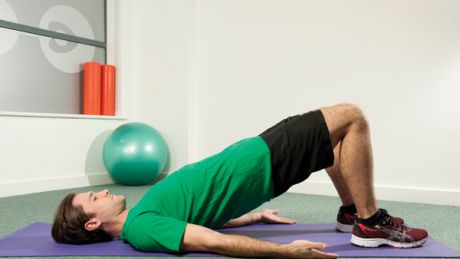Five Exercises To Minimise The Risk Of Shin Splints
Runners take note – your shins are relying on you

Although the benefits of running far outweigh the drawbacks, it is true that it puts your body under a fair bit of pressure, especially when you ramp up the training load ahead of a big event like a marathon.
Of course, that shouldn’t put you off running, but if you get serious about the sport it should motivate you to put in the work to help your body handle the load. While it’s impossible to completely injury-proof your body, the right kind of strength and conditioning work can reduce the risk of picking up common complaints like shin splints, achilles tendinitis or runner’s knee. That’s why we asked Erin Lahay, physiotherapist at Pure Sports Medicine, for the best exercises you can do to minimise your risk of shin splints.
And just to be clear: if you already have shin splints don’t use these exercises to fix the problem. Visit a physio to assess your injury and find out what you should do to deal with it, because shin splints can present in different ways and there isn’t a universal treatment. These exercises are for the runner in good nick hoping to avoid future issues.
Wall squat with calf raise
Muscles worked: Soleus (calf muscle) and quads
Stand with your back against a wall and your feet shoulder-width apart in front of you. Slide down the wall until your knees are bent at approximately 90°. Your knees should be directly above your heels. Pushing through your big toes, slowly lift and lower your heels 20 times or until your calf and quad muscles fatigue. Slide back up to return to the starting position. Repeat for a second set.
Bridge march
Muscles worked: Glutes and hamstrings
Lie on your back with your knees bent and your feet flat on the floor. Maintain a neutral spine as you squeeze your bottom and slowly roll up (focus on doing it vertebrae by vertebrae) off the floor. Keep your bottom elevated as you “march” your right leg by bringing your knee up towards your chest three times, being careful not to let your right hip drop. Repeat on the left side, and continue to alternate sides for approximately 30 seconds or until your glutes and hamstrings fatigue. Perform two or three sets. Keep your pelvis level and to avoid arching your lower back throughout the exercise.
Get the Coach Newsletter
Sign up for workout ideas, training advice, reviews of the latest gear and more.
Side-lying hip abduction
Muscles worked: Gluteus medius
Lie on one side facing away from a wall. Your shoulder and hip should be approximately a fist-width away from the wall, and your bottom knee bent at 90°. Keeping your top leg straight, raise it until the foot is around 15cm above the height of your hip. Push your heel against the wall. Hold this position for five seconds, focusing on getting a strong glute contraction and keeping your hips stable. Avoid letting your top hip open up or roll back towards the wall. Lower your leg back to the starting position and repeat approximately eight times or until your glutes fatigue. Then swap sides.
See related
- How To Spot, Avoid And Treat Shin Splints
- Runners! Look After Your Legs With These Achilles Tendon Exercises
- Common Running Injuries And What To Do About Them
Hip stability/resistance band side taps
Muscles worked: Gluteus medius
Loop a light resistance band around your ankles. Standing on one leg, drop into a quarter squat ensuring that your shoulder is in line with your hip, knee and ankle. Keeping most of your weight through the heel of the standing leg, tap your opposite toe in to out, maintaining tension in the resistance band. Keep your hips square and avoid letting your or ankle or knee roll inwards. You should feel your glutes working, mostly on the standing leg to stabilise your knee and ankle.
Ankle inversion
Muscles worked: Tibialis posterior (deep-lying calf muscle)
Sit on a chair with your knees slightly bent and your right foot flat on the floor. Cross your left leg over your right leg and wrap a resistance band tightly around your ankles. Keeping your toes pointed towards the floor and without moving your knee, turn the sole of your left foot towards the direction of your instep and point your foot inwards. Hold this position for two seconds, then slowly return to the starting position. Repeat for one minute, or until your calf muscle fatigues, then swap legs.
Pure Sports Medicine’s sixth clinic has just opened in Finsbury Square in the City of London

Nick Harris-Fry is a journalist who has been covering health and fitness since 2015. Nick is an avid runner, covering 70-110km a week, which gives him ample opportunity to test a wide range of running shoes and running gear. He is also the chief tester for fitness trackers and running watches, treadmills and exercise bikes, and workout headphones.









